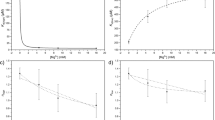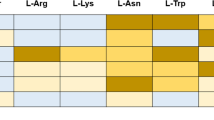Abstract
The interaction of transketolase ketosubstrates with the holoenzyme has been studied. On addition of ketosubstrates cleaving both irreversibly (hydroxypyruvate) and reversibly (xylulose 5-phosphate), identical changes in the CD spectrum at 300-360 nm are observed. The changes in this spectral region, as previously shown, are due to the formation of the catalytically active holoenzyme from the apoenzyme and the coenzyme, and the cleavage of ketosubstrates by transketolase. The identity of the changes in transketolase CD spectrum caused by the addition of reversibly or irreversibly cleaving substrates indicates that in the both cases the changes are due to the formation of an intermediate product of the transketolase reaction—a glycolaldehyde residue covalently bound to the coenzyme within the holoenzyme molecule. Usually, in the course of the transferase reaction, the glycolaldehyde residue is transferred to an aldose (acceptor substrate), resulting in the recycling of the holoenzyme free of the glycolaldehyde residue. The removal of the glycolaldehyde residue from the holoenzyme appears to proceed even in the absence of an aldose. However, the glycolaldehyde cannot be found the free state because it condenses with another glycolaldehyde residue formed in the course of the cleavage of another ketosubstrate molecule yielding erythrulose.
Similar content being viewed by others
REFERENCES
Kochetov, G. A. (1982) Meth. Enzymol., 90, 209-223.
Nikkola, M., Lindqvist, Y., and Schneider, G. (1994) J. Mol. Biol., 238, 387-404.
Meshalkina, L. E., and Kochetov, G. A. (1979) Biochim. Biophys. Acta, 51, 218-223.
Datta, A. G., and Racker, E. (1961) J. Biol. Chem., 236, 624-628.
Kochetov, G. A., Usmanov, R. A., and Mevkh, A. T. (1973) Biochem. Biophys. Res. Commun., 54, 1619-1626.
Nilsson, U., Meshalkina, L., Lindqvist, Y., and Schneider, G. (1997) J. Biol. Chem., 272, 1864-1869.
Tikhomirova, N. K., and Kochetov, G. A. (1990) Biochem. Int., 22, 31-36.
Heinrich, C. P., Noack, K., and Wiss, O. (1972) Biochem. Biophys. Res. Commun., 49, 1427-1432.
Mori, K., Hosomi, S., Tomoyuki, T., and Mizoguchi, T. (1985) Analyt. Biochem., 151, 188-191.
Kochetov, G. A., Usmanov, R. A., and Merzlov, V. P. (1970) FEBS Lett., 9, 265-266.
Heinrich, C. P., Noack, K., and Wiss, O. (1971) Biochem. Biophys. Res. Commun., 44, 275-279.
Usmanov, R. A., and Kochetov, G. A. (1978) Biokhimiya, 43, 1796-1804.
Kochetov, G. A., Meshalkina, L. E., and Usmanov, R. A. (1976) Biochem. Biophys. Res. Commun., 69, 839-843.
Pustynnikov, M. G., Neif, X., Usmanov, R. A., Schellenberger, A., and Kochetov, G. A. (1986) Biokhimyia, 51, 1003-1016.
Author information
Authors and Affiliations
Rights and permissions
About this article
Cite this article
Solov'eva, O.N., Bykova, I.A., Meshalkina, L.E. et al. Cleaving of Ketosubstrates by Transketolase and the Nature of the Products Formed. Biochemistry (Moscow) 66, 932–936 (2001). https://doi.org/10.1023/A:1011921223198
Issue Date:
DOI: https://doi.org/10.1023/A:1011921223198




